Frequently Asked Questions
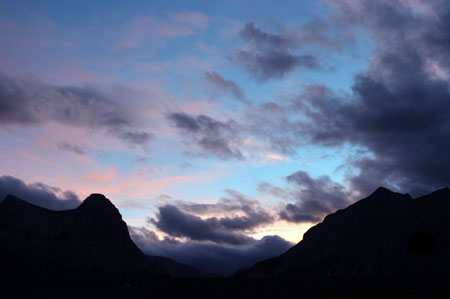
Photo by Michael Jennek
FREQUENTLY ASKED QUESTIONS
1. What kind of weather can I expect on my holiday to the Canadian Rockies?
Spring
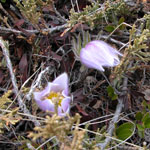
Crocus on Hoodoo Trail, BNP
Marcel Finnigan
Springtime in the Rockies is a special time, as the trees and flowers burst with colour. Unfortunately, our spring comes in late May because of our high elevation and cool temperatures.
Rain can turn to snow in the blink of an eye, so don't be caught without the appropriate clothing! Layers are the key!! You can always take off, if the sun comes out strong, and add, if a cold wind and nasty clouds show up on your hike.
Remember that nights in the Rockies are cool - you would probably consider them cold - so make sure to pack extra clothes. Gloves are great when biking, especially on an early crisp morning.
Summer
Our summer really begins in July. Sure, June can bring beautiful sunny weather, but it can also bring rain, and lots of it!! June also brings with it the summer equinox which means extra hours of sunlight to enjoy all those outdoor activities!!
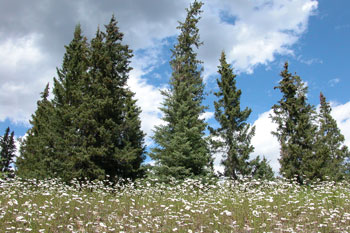
Wildflowers at Cascade, BNP
Leanne Boytinck
Go on a hike to the many wildflower meadows and make the most out of our short growing season.
Missing the snow already? Just look up into the mountain peaks and chances are, the last rain storm sprinkled the peaks with some powdered sugar!!
Summer can be really hot. Although our climate is dry, and not humid, the intense sun can burn you in an afternoon. Sunblock, sunglasses, a hat and proper clothing are a must! You don't want to suffer the rest of your holiday!
Fall
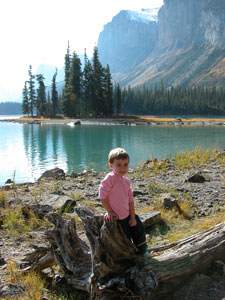
Fall at Spirit Island, JNP
Marcel Finnigan
The autumn or fall season is really my favourite!! The days are still warm and the colours and smells of the forests are at their best. I just love watching the larches turn gold on the mountains in Lake Louise in Banff National Park and Maligne Lake in Jasper National Park.
The air is crisp and clear and the days are becoming noticeably shorter. The family tourists are back home, and the season is not as busy as in the summer months.
Take advantage of the weather and go for long hikes and observe how the wildlife prepare for winter. The rutting or breeding season begins for the elk and the bull elk are busy gathering up their harem of cows, fighting off any male competitors. Keep your distance from these aggressive animals!
Winter
The first snowfall can be as early as September, but it usually doesn't stick around for long. Expect the real thing to happen in late October or early November when the temperatures really start to dip.
Did I say "first snowfall"? What I really meant by that was the first snowfall of the winter season!! It can (and has) snowed in every month of the calendar! In December and Janaury there is usually what we Canadians call a "cold snap", which means temperatures anywhere between -25 to -40. These temps can last a couple days or 6 weeks. In any case, you can be sure that the local population is just praying for a good ole' chinook!! A chinook (meaning "snow-eater") is a warm wind that blows in over the mountains and gives us a much-needed break from those paralyzing winter temperatures.
2. What time is it in the Canadian Rocky Mountains?
In the summer months, here in Alberta, we are in Mountain Daylight Time or MDT, which means we have daylight saving time which is +1 hour compared to our usual Mountain Standard Time or MST in the winter months.
Standard time zone: UTC/GMT -7 hours Our Daylight Savings started on Sunday, March 11, 2007 at 2:00 AM local standard time, and it will end on Sunday, November 4, 2007 at 2:00 AM local daylight time.
3. Does Canada use miles or kilometers?
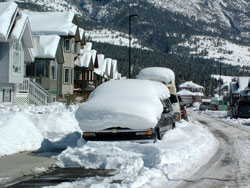
Canmore after an April Snowstorm
Marcel Finnigan
In March and April the days tend to be warmer but somehow that only brings more snow!! The blizzards in early spring are amazing and can cause great havock, even for us Canadians. Snow is literally dumped on us at an incredible rate. These blizzards do, however, bring smiles to all our visitors who planned their holiday with skiing and snowboarding in mind. The deep white powder also makes for some great pictures.
Be aware of the windchill factor, which is often broadcasted on the radio, or mentioned on the web. Windchill is the actual temperature your skin will feel outside with the cold wind factor taken into consideration when measuring "coldness". This is also usually followed by a comment on how many seconds it will take for bare skin to freeeeeze! Dress warmly to avoid frostbite!!
Daylight saving time: +1 hour
So, at present in Calgary, Alberta it is
We use kilometers on maps and signs, however our land is generally sectioned off in miles. How can this be?
As a British colony, Canada used to use the United Kingdom's imperial system but started to convert over to the metric system in the 1970s. As you can imagine, it is not easy to change the way a society thinks - especially with such a commonly useful tool as measurement. As a result, we officially use the metric system, but in our daily lives (like at the hardware store!), we will commonly use the old imperial system with inches, feet and yards. Temperature is calculated in degrees Celsius except for in our kitchens where our ovens are still in Fahrenheit. Weight is generally metric, except when you ask us our personal weight - which we usually refer to in pounds. Confused? So are we sometimes when we have to teach our children!! To help you on your stay, here are the most important metric conversions:
METRIC CONVERSIONS
In the end, don't sweat it - Canadians usually understand both systems and should be able to help you.




